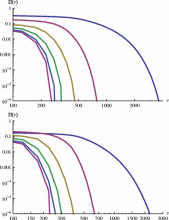
Abstract
We explore the newly discovered “hangup-kick” effect, which greatly amplifies the recoil for configurations with partial spin-/orbital angular momentum alignment, by studying a set of 48 new simulations of equal-mass, spinning black-hole binaries. We propose a phenomenological model for the recoil that takes this new effect into account and then use this model, in conjunction with statistical distributions for the spin magnitude and orientations, based on accretion simulations, to find the probabilities for observing recoils of several thousand km s-1. In addition, we provide initial parameters, eccentricities, radiated linear and angular momentum, precession rates and remnant mass, spin, and recoils for all 48 configurations. Our results indicate that surveys exploring peculiar (redshifted or blueshifted) differential line-of-sight velocities should observe at least one case above 2000 km s-1 out of 4000 merged galaxies. On the other hand, the probability that a remnant black hole recoils in any direction at a velocity exceeding the ∼2000 km s-1 escape velocity of large elliptical galaxies is 0.03%. Probabilities of recoils exceeding the escape velocity quickly rise to 5% for galaxies with escape velocities of 1000 km s-1 and nearly 20% for galaxies with escape velocities of 500 km s-1. In addition the direction of these large recoils is strongly peaked toward the angular momentum axis, with very low probabilities of recoils exceeding 350 km s-1 for angles larger than 45° with respect to the orbital angular momentum axis.